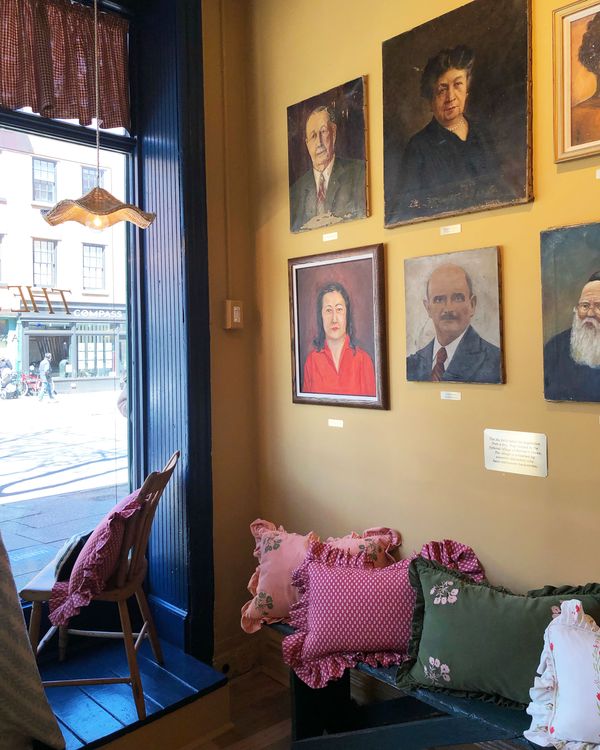
The general impression a person has of a village probably depends very much on one’s ethnic background and social location. My own sense is colored by having spent my formative years in the West Midlands village of Alvechurch, England, which is notable for having birthed that silverest of foxes, Charles Dance, and for hosting a distinctive species of bright-orange slug the color and texture of a Cornish mussel. My mother tells me they’ve got a co-op now, too. I once got gay-bashed at the local pub and harassed for wearing a puffy plum gilet; I haven’t looked, but I’d be shocked if the good people of the town didn’t smudge the ballot for Brexit. It’s difficult for those of us who escaped a village to find much to enjoy about its memory.
Not so, thinks Audrey Gelman, co-founder of The Wing, who has developed a familiar if still completely baffling brand concept. At Gelman’s new shop on Court Street, the Six Bells, you can buy chintzy village-themed tat from “a little world far away,” resurrecting that outdated and unlovely neoliberal fantasy of the “global village.” Those who wish to do so can buy crafts from India, London, and Appalachia — any number of places that share only a whiff of villagey-ness, a sense of small-scale (sustainable, maybe?) collective self-sufficiency (though one wonders who exactly is printing these napkins by hand).
So far, so Brooklyn. But there’s a twist: As the store’s website announces, the Six Bells “takes its inspiration from the fictional village of Barrow’s Green, a small civil parish with 640 residents, depending on who is dying and how many babies are being born.” In other words, Gelman has built a small immersive fiction around her knickknack emporium and populated it with a small number of mostly clerical buildings and a handful of “unusual characters” for whom she has written paragraph-long descriptions. You know, as rich teenagers do after they first read Jane Austen.
Look! Here’s a neoclassical “courthouse” straight out of the American Colonial period. There are two stately homes, presumably so a comely young maiden can be wooed by the stout horseman from the grange without anyone troubling too much about the gene pool. Then there’s a fancyish cottage, a couple of places for (1) the vicar and (2) the rabbi, whose name is Rabbi Haskel Frumkin and who “often joins with the town’s Vicar for interdenominational services, and enjoys watching cricket.” Genial and assimilationist! The remaining plebes of the parish — sorry, Rabbi Frumkin, but they use the ecclesiastical toponym in Barrow’s Green — must squeeze into the terrace by the post office, one presumes, or into a row of extremely small gray cabins buried in a thicket of trees.
Now don’t get me wrong: I am exactly the target market for this nonsense. I live in Carroll Gardens, where the store is located; I regularly drop a hundred bucks I don’t have on tidbits from any of the neighborhood’s already numerous tidbit stores. I have a standing order at Diptyque, and I don’t care if it’s not cool anymore. And there is, of course, something vaguely virtuous about offering craftwork and artisanal labor as the solution to the alienated conditions of modern-day consumption. It’s an idea as old as the English village, which is to say a 19th-century fantasy concocted to compensate for the alienation of the industrial city. William Morris would be proud.
Notwithstanding the neoclassical pillars outside the courthouse, can we admit that, with Barrow’s Green, Gelman has grafted a post-pandemic Brooklynite’s longing for the upstate life onto a more reactionary kind of Anglophilia? She casts a fond American gaze toward the English village many of us fled to New York to escape — the village of warm beer and cold cuts. (The village next to Alvechurch, incidentally, is called Barnt Green; one of the white singers from the pop-reggae band UB40 lives there.) What motivates Gelman’s attempt to rehabilitate this fantasy of cricket, justice, epistolary communication, and outrageous wealth disparity? The whiteness of the fantasy village will appall some — including, presumably, those who protested Gelman’s leadership of The Wing, that women-only co-working operation whose own workforce was notoriously segregated by race. (Gelman stepped down amid protests that she had abused her position to defend a white guest at The Wing over a Black member.) Perhaps others will be placated by the inclusion of the only inhabitant of color in Barrow’s Green: Sylvia Dudley Ward, a newspaper editor who “has received and declined several overtures from the married Lord Ashborne.” But not me. Let the English village fall back into the English sod.




